Monitoring Total Phosphorus Concentration in the Middle Reaches of the Yangtze River Using Sentinel-2 Satellites
Abstract
:1. Introduction
2. Study Area
3. Materials and Methods
3.1. Measured Data
3.2. Sentinel-2 Data and Processing
3.3. Retrieval Model of TP
- (1)
- The input and output data were normalized to a range of −1 to 1. We divided the data into two parts, training and validation at a ratio of 3:1, and ensured that the input and output of each sample were spatially and temporally consistent.
- (2)
- We used the newrb() function to construct the RBFNN.
- (3)
- The three-band combination with the best correlation with turbidity or TP concentration is used as the input to the RBFNN (Figure 2), and the measured turbidity or TP concentration is used as the output for training the samples to the required accuracy.
- (4)
- The SIM function was used for simulation according to the model, and the turbidity of the MYR was obtained through inverse normalization.
- (5)
- Steps 1–4 were repeated to evaluate the TP concentrations, but the input parameters for the TP retrieval model were reflectance and turbidity. We divided the data between Model A and B based on the difference in input parameters (Figure 3); model A has only reflectance as an input parameter and model B has reflectance and turbidity as input parameters.
3.4. Statistical Metrics
4. Results
4.1. Model Performance
4.2. Variability of Turbidity and TP Concentration in the MYR
5. Discussions
5.1. The Limitations and Uncertainty of the Model
5.2. The Influence of Dongting Lake on the Water Quality in the MYR
6. Conclusions
Author Contributions
Funding
Data Availability Statement
Acknowledgments
Conflicts of Interest
References
- Maavara, T.; Parsons, C.T.; Ridenour, C.; Stojanovic, S.; Dürr, H.H.; Powley, H.R.; Van Cappellen, P. Global phosphorus retention by river damming. Proc. Natl. Acad. Sci. USA 2015, 112, 15603–15608. [Google Scholar] [CrossRef] [PubMed]
- Withers, P.; Jarvie, H. Delivery and cycling of phosphorus in rivers: A review. Sci. Total Environ. 2008, 400, 379–395. [Google Scholar] [CrossRef] [PubMed]
- Ho, J.C.; Michalak, A.M.; Pahlevan, N. Widespread global increase in intense lake phytoplankton blooms since the 1980s. Nature 2019, 574, 667–670. [Google Scholar] [CrossRef] [PubMed]
- Xiong, J.F.; Lin, C.; Cao, Z.G.; Hu, M.Q.; Xue, K.; Chen, X.; Ma, R.H. Development of remote sensing algorithm for total phosphorus concentration in eutrophic lakes: Conventional or machine learning? Water Res. 2022, 215, 11. [Google Scholar] [CrossRef] [PubMed]
- Du, C.; Wang, Q.; Li, Y.; Lyu, H.; Zhu, L.; Zheng, Z.; Wen, S.; Liu, G.; Guo, Y. Estimation of total phosphorus concentration using a water classification method in inland water. Int. J. Appl. Earth Obs. Geoinform. 2018, 71, 29–42. [Google Scholar] [CrossRef]
- Powers, S.M.; Bruulsema, T.W.; Burt, T.P.; Chan, N.I.; Elser, J.J.; Haygarth, P.M.; Howden, N.J.K.; Jarvie, H.P.; Lyu, Y.; Peterson, H.M.; et al. Long-term accumulation and transport of anthropogenic phosphorus in three river basins. Nat. Geosci. 2016, 9, 353–356. [Google Scholar] [CrossRef]
- Ding, S.; Chen, P.; Liu, S.; Zhang, G.; Zhang, J.; Dan, S.F. Nutrient dynamics in the Changjiang and retention effect in the Three Gorges Reservoir. J. Hydrol. 2019, 574, 96–109. [Google Scholar] [CrossRef]
- Hu, M.; Liu, Y.; Zhang, Y.; Shen, H.; Yao, M.; Dahlgren, R.A.; Chen, D. Long-term (1980–2015) changes in net anthropogenic phosphorus inputs and riverine phosphorus export in the Yangtze River basin. Water Res. 2020, 177, 115779. [Google Scholar] [CrossRef] [PubMed]
- Records, R.M.; Wohl, E.; Arabi, M. Phosphorus in the river corridor. Earth-Sci. Rev. 2016, 158, 65–88. [Google Scholar] [CrossRef]
- Yang, Y.; Gao, B.; Hao, H.; Zhou, H.D.; Lu, J. Nitrogen and phosphorus in sediments in China: A national-scale assessment and review. Sci. Total Environ. 2017, 576, 840–849. [Google Scholar] [CrossRef] [PubMed]
- Cao, Z.; Ma, R.; Melack, J.M.; Duan, H.; Liu, M.; Kutser, T.; Xue, K.; Shen, M.; Qi, T.; Yuan, H. Landsat observations of chlorophyll-a variations in Lake Taihu from 1984 to 2019. Int. J. Appl. Earth Obs. Geoinform. 2022, 106, 102642. [Google Scholar] [CrossRef]
- Volpe, V.; Silvestri, S.; Marani, M. Remote sensing retrieval of suspended sediment concentration in shallow waters. Remote Sens. Environ. 2011, 115, 44–54. [Google Scholar] [CrossRef]
- Dogliotti, A.; Ruddick, K.G.; Nechad, B.; Doxaran, D.; Knaeps, E. A single algorithm to retrieve turbidity from remotely-sensed data in all coastal and estuarine waters. Remote Sens. Environ. 2015, 156, 157–168. [Google Scholar] [CrossRef]
- Cao, Z.; Duan, H.; Feng, L.; Ma, R.; Xue, K. Climate- and human-induced changes in suspended particulate matter over Lake Hongze on short and long timescales. Remote Sens. Environ. 2017, 192, 98–113. [Google Scholar] [CrossRef]
- Gao, Y.; Gao, J.; Yin, H.; Liu, C.; Xia, T.; Wang, J.; Huang, Q. Remote sensing estimation of the total phosphorus concentration in a large lake using band combinations and regional multivariate statistical modeling techniques. J. Environ. Manag. 2015, 151, 33–43. [Google Scholar] [CrossRef] [PubMed]
- Wu, C.; Wu, J.; Qi, J.; Zhang, L.; Huang, H.; Lou, L.; Chen, Y. Empirical estimation of total phosphorus concentration in the mainstream of the Qiantang River in China using Landsat TM data. Int. J. Remote Sens. 2010, 31, 2309–2324. [Google Scholar] [CrossRef]
- Carlson, R.E. A trophic state index for lakes. Limnol. Oceanogr. 1977, 22, 361–369. [Google Scholar] [CrossRef]
- Huang, C.; Guo, Y.; Yang, H.; Li, Y.; Zou, J.; Zhang, M.; Lyu, H.; Zhu, A.; Huang, T. Using Remote Sensing to Track Variation in Phosphorus and Its Interaction with Chlorophyll-a and Suspended Sediment. IEEE J. Sel. Top. Appl. Earth Obs. Remote Sens. 2015, 8, 4171–4180. [Google Scholar] [CrossRef]
- Li, Y.; Zhang, Y.L.; Shi, K.; Zhu, G.W.; Zhou, Y.Q.; Zhang, Y.B.; Guo, Y.L. Monitoring spatiotemporal variations in nutrients in a large drinking water reservoir and their relationships with hydrological and meteorological conditions based on Landsat 8 imagery. Sci. Total Environ. 2017, 599, 1705–1717. [Google Scholar] [CrossRef] [PubMed]
- Wang, S.; Shen, M.; Liu, W.; Ma, Y.; Shi, H.; Zhang, J.; Liu, D. Developing remote sensing methods for monitoring water quality of alpine rivers on the Tibetan Plateau. GISci. Remote Sens. 2022, 59, 1384–1405. [Google Scholar] [CrossRef]
- Zhao, J.R.; Jin, S.G.; Zhang, Y.Y. Dynamic Water Quality Changes in the Main Stream of the Yangtze River from Multi-Source Remote Sensing Data. Remote Sens. 2023, 15, 2526. [Google Scholar] [CrossRef]
- Dai, Z.; Du, J.; Zhang, X.; Su, N.; Li, J. Variation of Riverine Material Loads and Environmental Consequences on the Changjiang (Yangtze) Estuary in Recent Decades (1955–2008). Environ. Sci. Technol. 2010, 45, 223–227. [Google Scholar] [CrossRef] [PubMed]
- Deng, C.; Liu, L.; Li, H.; Peng, D.; Wu, Y.; Xia, H.; Zhang, Z.; Zhu, Q. A data-driven framework for spatiotemporal characteristics, complexity dynamics, and environmental risk evaluation of river water quality. Sci. Total Environ. 2021, 785, 147134. [Google Scholar] [CrossRef] [PubMed]
- Liu, L.S.; Huang, G.X.; Wang, F.; Chu, Z.S.; Li, H.S. Main Problems, Situation and Countermeasures of Water Eco-Environment Security in the Yangtze River Basin. Res. Environ. Sci. 2020, 33, 1081–1090. (In Chinese) [Google Scholar]
- Yin, W.; Wang, C.; Zhang, H. Consideration on total phosphorus problem in Yangtze River Basin. Yangtze River 2022, 53, 44–52. (In Chinese) [Google Scholar]
- Jia, H.; Chen, F.; Pan, D.; Du, E.; Wang, L.; Wang, N.; Yang, A. Flood risk management in the Yangtze River basin—Comparison of 1998 and 2020 events. Int. J. Disaster Risk Reduct. 2022, 68, 102724. [Google Scholar] [CrossRef]
- Yang, F.; He, B.; Zhou, Y.; Li, W.; Zhang, X.; Feng, Q. Trophic status observations for Honghu Lake in China from 2000 to 2021 using Landsat Satellites. Ecol. Indic. 2023, 146, 109898. [Google Scholar] [CrossRef]
- Main-Knorn, M.; Pflug, B.; Louis, J.; Debaecker, V.; Muller-Wilm, U.; Gascon, F. Sen2Cor for Sentinel-2. In Proceedings of the Conference on Image and Signal Processing for Remote Sensing XXIII, Warsaw, Poland, 11–14 September 2017. [Google Scholar]
- McFeeters, S.K. The use of the Normalized Difference Water Index (NDWI) in the delineation of open water features. Int. J. Remote Sens. 1996, 17, 1425–1432. [Google Scholar] [CrossRef]
- Zhou, Y.; He, B.; Xiao, F.; Feng, Q.; Kou, J.; Liu, H. Retrieving the Lake Trophic Level Index with Landsat-8 Image by Atmospheric Parameter and RBF: A Case Study of Lakes in Wuhan, China. Remote Sens. 2019, 11, 457. [Google Scholar] [CrossRef]
- Ma, R.; Duan, H.; Tang, J.; Chen, Z.; Al, E. Remote Sensing on Water Environment of Lakes; Sciences Press: Beijing, China, 2010. (In Chinese) [Google Scholar]
- Wang, C.; Li, W.; Chen, S.; Li, D.; Wang, D.; Liu, J. The spatial and temporal variation of total suspended solid concentration in Pearl River Estuary during 1987–2015 based on remote sensing. Sci. Total Environ. 2018, 618, 1125–1138. [Google Scholar] [CrossRef] [PubMed]
- Tham, T.T.; Hung, T.L.; Thuy, T.T.; Mai, V.T.; Trinh, L.T.; Hai, C.V.; Minh, T.B. Assessment of some water quality parameters in the Red River downstream, Vietnam by combining field monitoring and remote sensing method. Environ. Sci. Pollut. Res. 2022, 29, 41992–42004. [Google Scholar] [CrossRef] [PubMed]
- Umar, M.; Rhoads, B.L.; Greenberg, J.A. Use of multispectral satellite remote sensing to assess mixing of suspended sediment downstream of large river confluences. J. Hydrol. 2018, 556, 325–338. [Google Scholar] [CrossRef]
- Fang, C.; Song, C.; Wang, X.; Wang, Q.; Tao, H.; Wang, X.; Ma, Y.; Song, K. A novel total phosphorus concentration retrieval method based on two-line classification in lakes and reservoirs across China. Sci. Total Environ. 2023, 906, 167522. [Google Scholar] [CrossRef] [PubMed]
- Guo, H.; Tian, S.; Huang, J.J.; Zhu, X.; Wang, B.; Zhang, Z. Performance of deep learning in mapping water quality of Lake Simcoe with long-term Landsat archive. ISPRS J. Photogramm. Remote Sens. 2022, 183, 451–469. [Google Scholar] [CrossRef]
- Song, K.; Li, L.; Li, S.; Tedesco, L.; Hall, B.; Li, L. Hyperspectral Remote Sensing of Total Phosphorus (TP) in Three Central Indiana Water Supply Reservoirs. Water Air Soil Pollut. 2012, 223, 1481–1502. [Google Scholar] [CrossRef]
- Liu, H.; He, B.; Zhou, Y.; Yang, X.; Zhang, X.; Xiao, F.; Feng, Q.; Liang, S.; Zhou, X.; Fu, C. Eutrophication monitoring of lakes in Wuhan based on Sentinel-2 data. GISci. Remote Sens. 2021, 58, 776–798. [Google Scholar] [CrossRef]
- Wang, L.; Peng, Z.; Ma, X.; Zheng, Y.; Chen, C. Multiscale gravity measurements to characterize 2020 flood events and their spatio-temporal evolution in Yangtze river of China. J. Hydrol. 2021, 603, 127176. [Google Scholar] [CrossRef]
- Ma, J.H. Work and achievements of flood prevention in the Yangtze River Basin in 2021. China Water Resour. 2022, 5, 12–15. (In Chinese) [Google Scholar]
- Yang, Y.; Zheng, J.; Zhu, L.; Zhang, H.; Wang, J. Influence of the Three Gorges Dam on the transport and sorting of coarse and fine sediments downstream of the dam. J. Hydrol. 2022, 615, 128654. [Google Scholar] [CrossRef]
- Zhang, Y.N.; Guo, L.C.; Yu, H.S.; He, Q. Changes in suspended sediment grain size along the mainstream of the Yangtze River under the influences of cascade dams. J. Sediment Res. 2022, 47, 51–58. (In Chinese) [Google Scholar]
- Yang, W.; Deng, G.D.; Zhang, S.; Xie, P.; Guo, L.G.; Wang, S.R. Seasonal dynamic and spatial distribution of chlorophyll-a concentration in Lake Erhai. J. Lake Sci. 2012, 24, 858–864. (In Chinese) [Google Scholar]
- Zhang, F.; Li, J.; Shen, Q.; Zhang, B.; Tian, L.; Ye, H.; Wang, S.; Lu, Z. A soft-classification-based chlorophyll-a estimation method using MERIS data in the highly turbid and eutrophic Taihu Lake. Int. J. Appl. Earth Obs. Geoinform. 2018, 74, 138–149. [Google Scholar] [CrossRef]
- Béjaoui, B.; Armi, Z.; Ottaviani, E.; Barelli, E.; Gargouri-Ellouz, E.; Chérif, R.; Turki, S.; Solidoro, C.; Aleya, L. Random Forest model and TRIX used in combination to assess and diagnose the trophic status of Bizerte Lagoon, southern Mediterranean. Ecol. Indic. 2016, 71, 293–301. [Google Scholar] [CrossRef]
- Chen, Q.; Huang, M.; Tang, X. Eutrophication assessment of seasonal urban lakes in China Yangtze River Basin using Landsat 8-derived Forel-Ule index: A six-year (2013–2018) observation. Sci. Total Environ. 2020, 745, 135392. [Google Scholar] [CrossRef] [PubMed]
- Ji, B.; Liu, C.; Liang, J.; Wang, J. Seasonal Succession of Bacterial Communities in Three Eutrophic Freshwater Lakes. Int. J. Environ. Res. Public Health 2021, 18, 6950. [Google Scholar] [CrossRef] [PubMed]
- Tian, Z.B.; Zheng, B.H.; Wang, L.J.; Li, H.; Wang, X. Effects of river-lake interactions in water and sediment on phosphorus in Dongting Lake, China. Environ. Sci. Pollut. Res. 2017, 24, 23250–23260. [Google Scholar] [CrossRef] [PubMed]
- Xiong, J.; Yu, F.Q.; Tian, Q.; Huang, D.Z.; Li, L.Q. The evolution of water quality and nutrient condition in Lake Dongting in recent 30 years. J. Lake Sci. 2016, 28, 1217–1225. (In Chinese) [Google Scholar]
- Tian, Z.; Wang, L.; Li, Y.; Zheng, B.; Chu, Z. Changes of phosphorus delivery from Yangtze River to Dongting Lake under new water and sediment conditions. J. Clean. Prod. 2021, 316, 128248. [Google Scholar] [CrossRef]
- Yu, Y.; Mei, X.; Dai, Z.; Gao, J.; Li, J.; Wang, J.; Lou, Y. Hydromorphological processes of Dongting Lake in China between 1951 and 2014. J. Hydrol. 2018, 562, 254–266. [Google Scholar] [CrossRef]

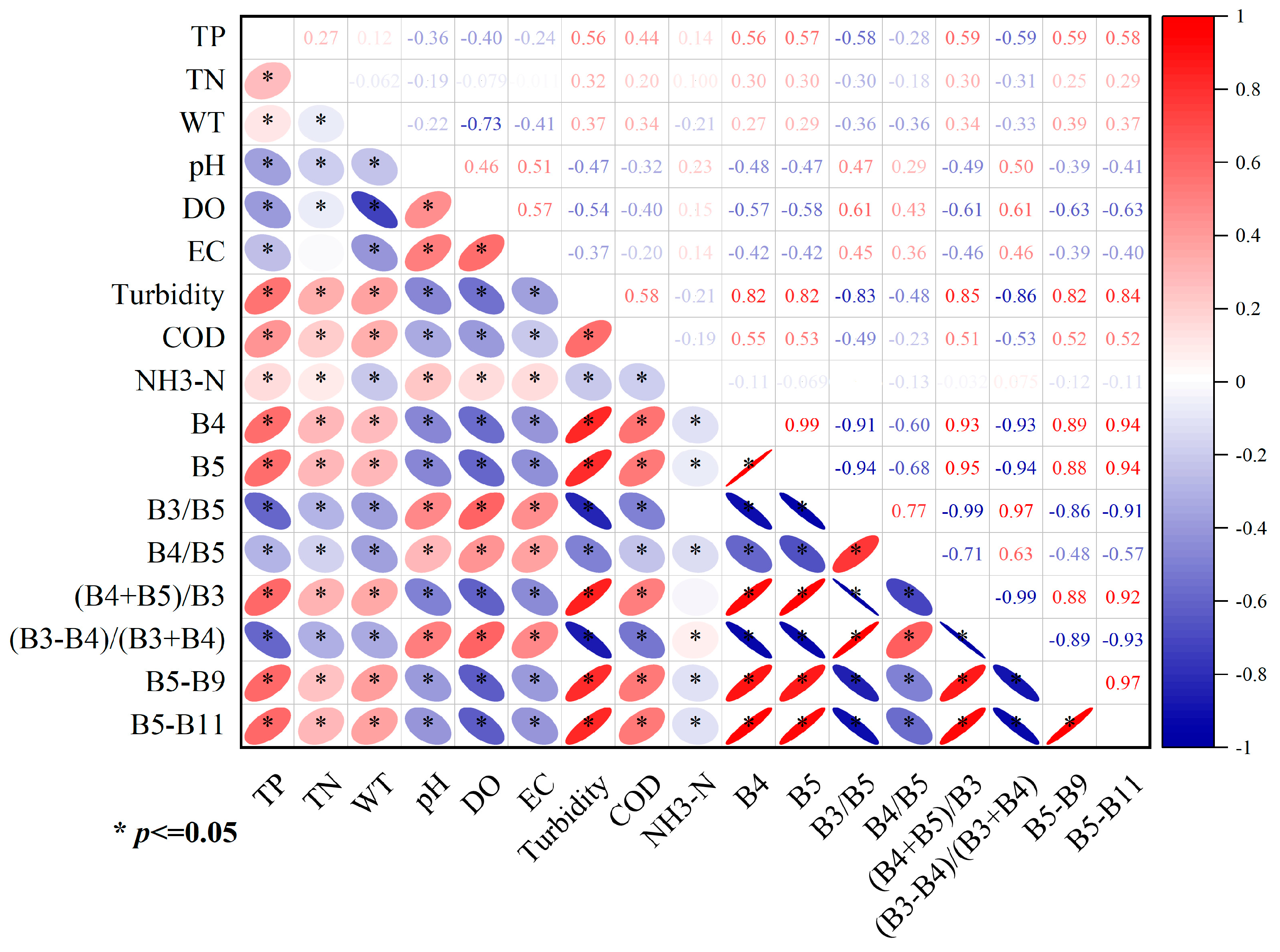
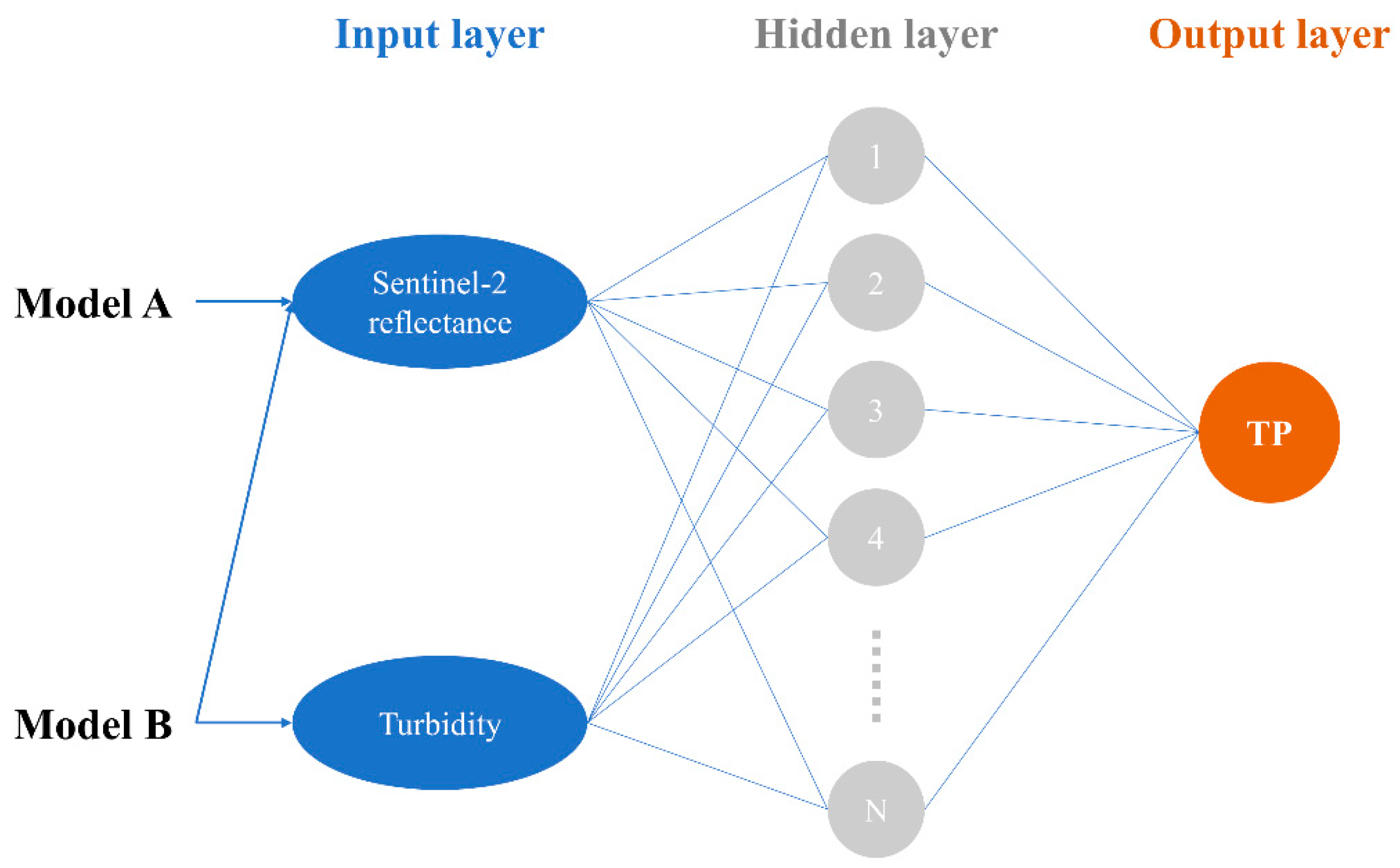
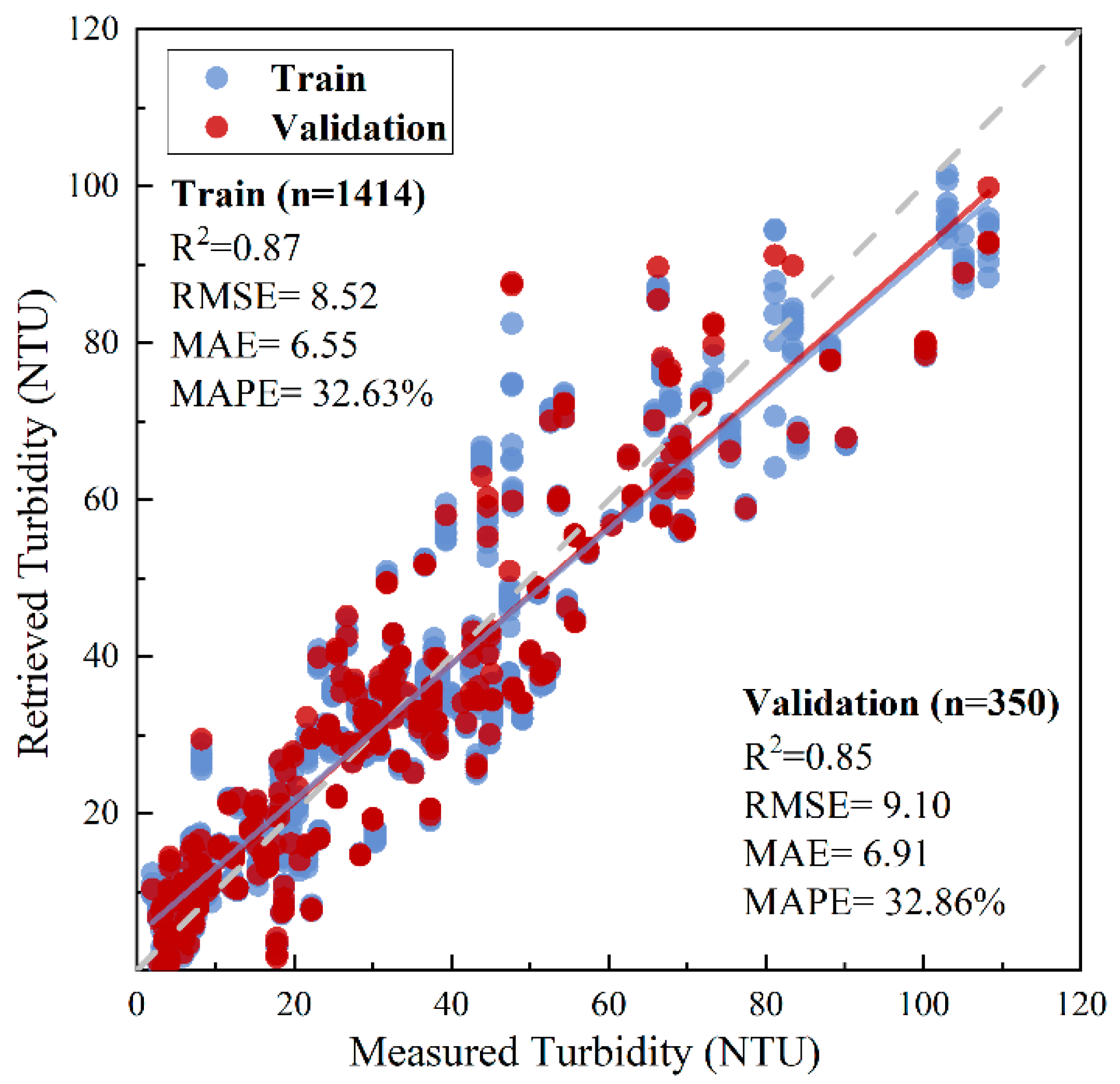

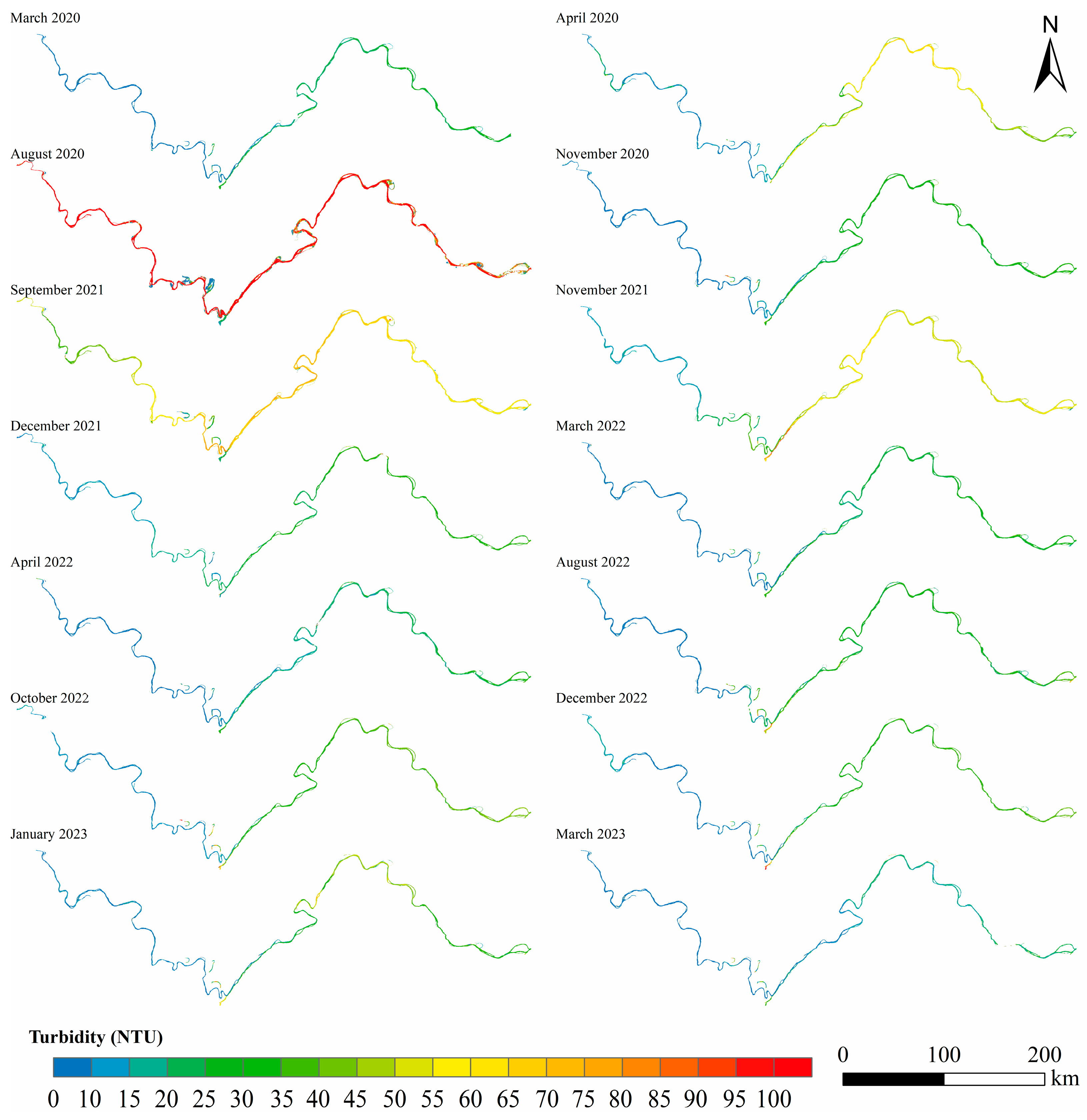
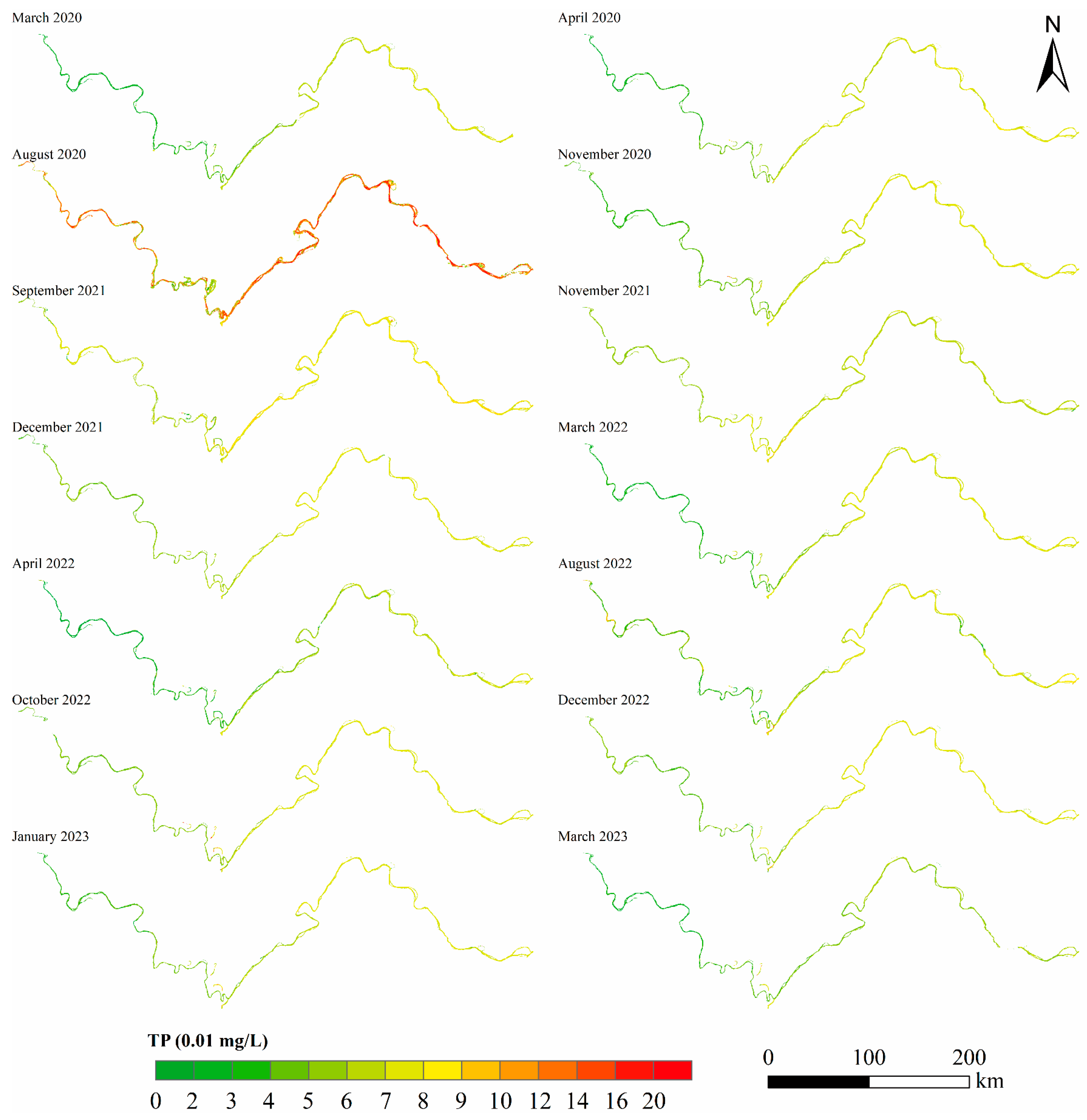
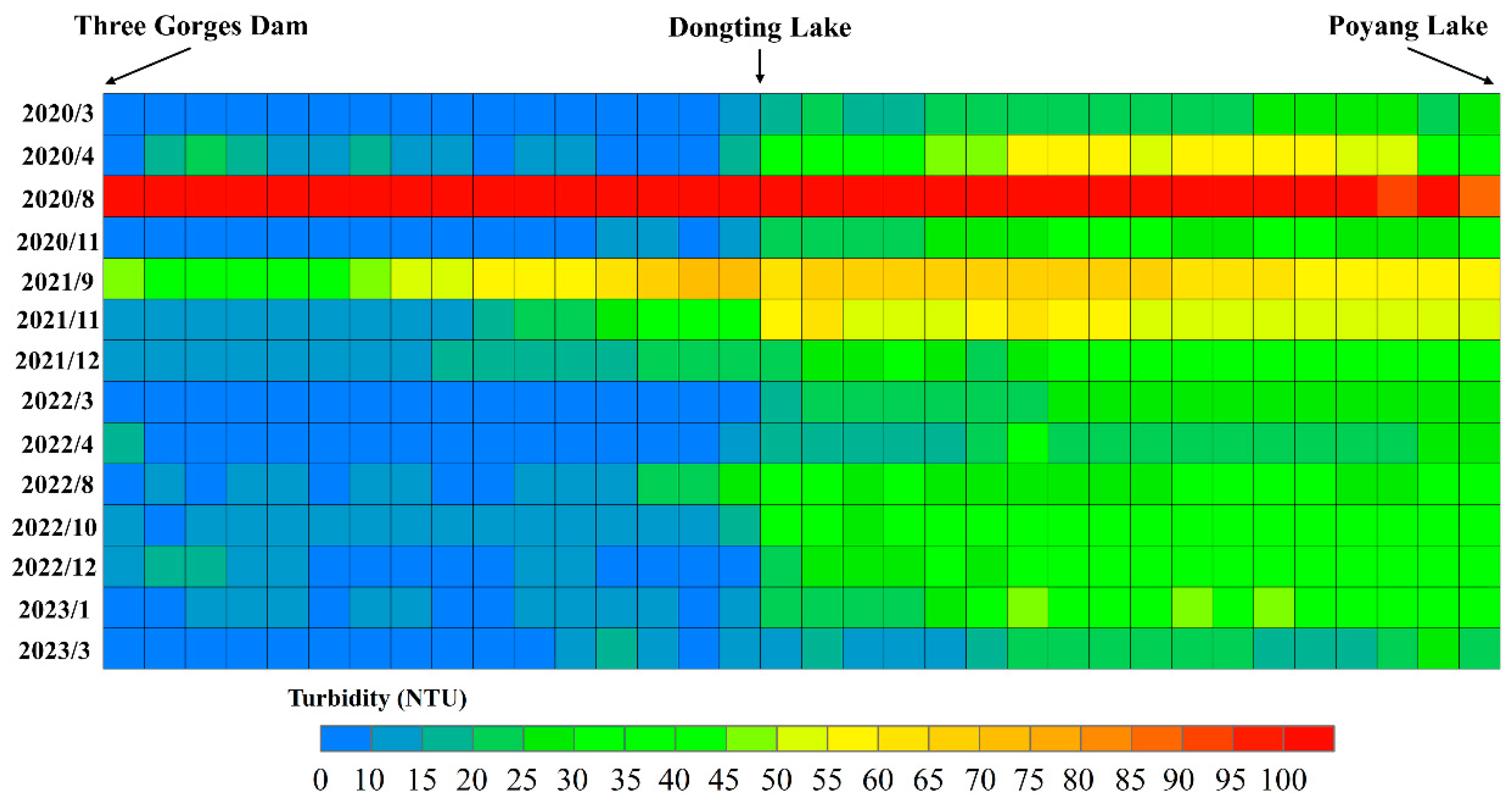

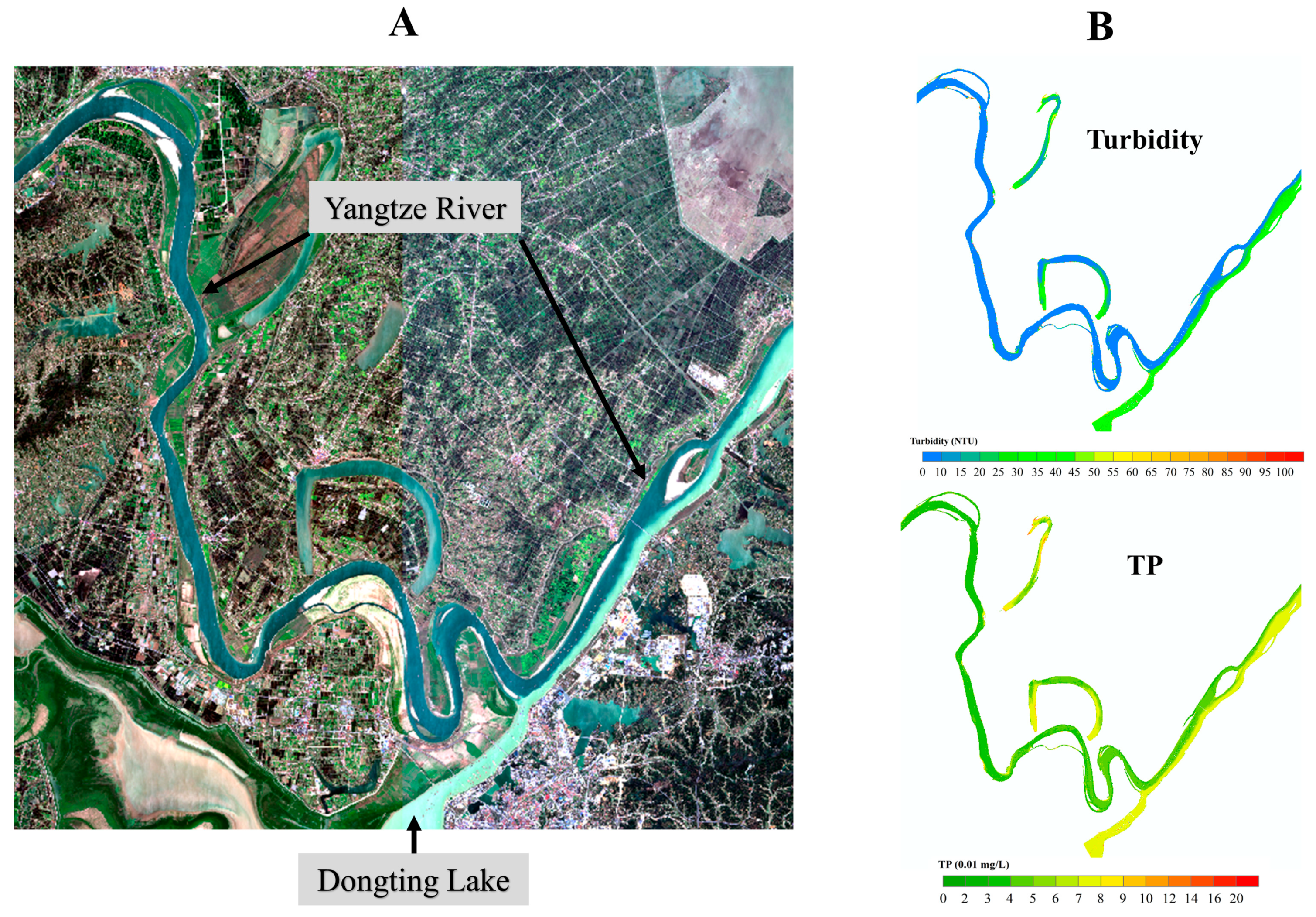
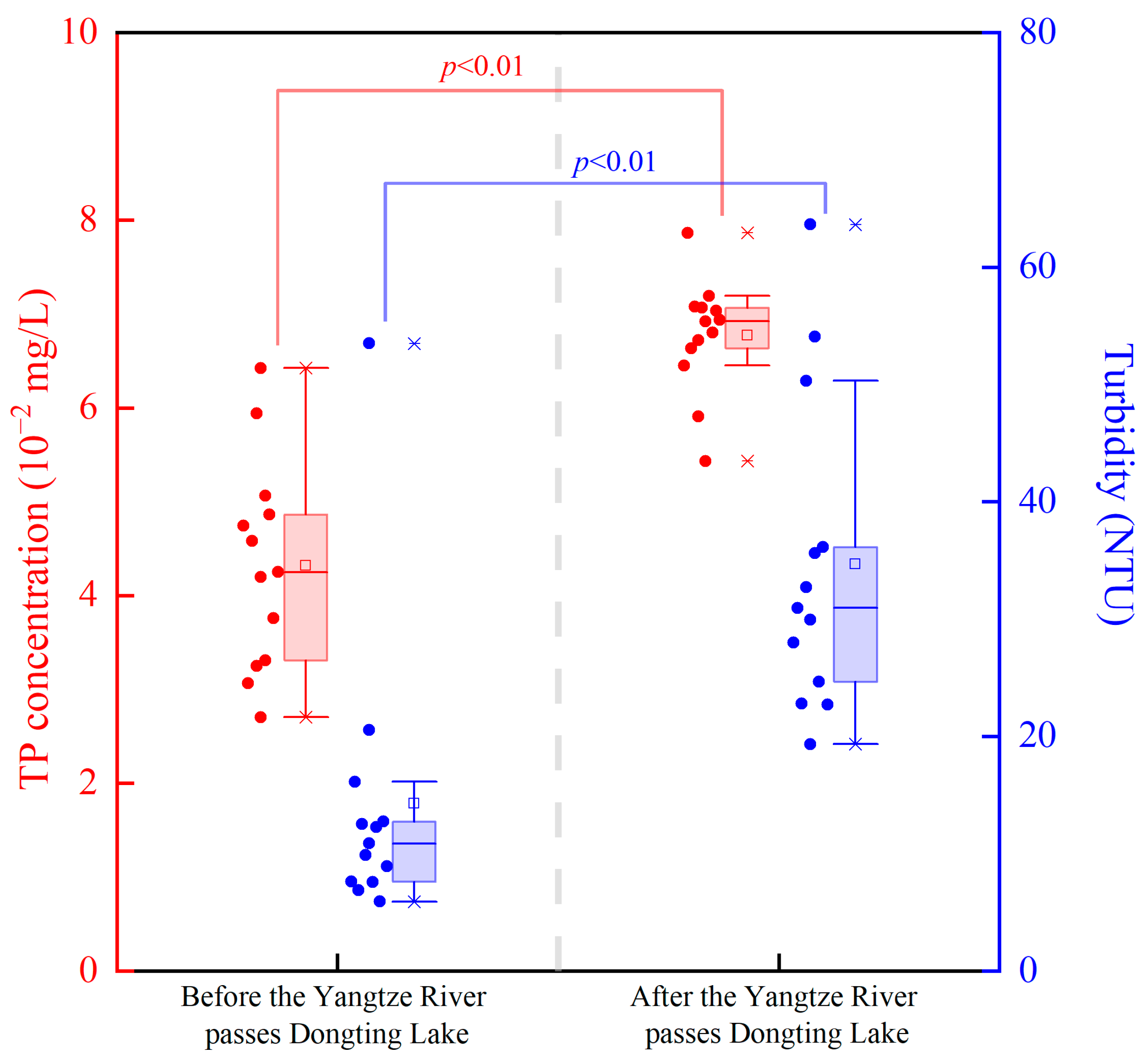
| Range | Mean ± Std | Median | Q25–Q75 | |
|---|---|---|---|---|
| TP (mg/L) | 0.01–0.162 | 0.068 ± 0.024 | 0.067 | 0.05–0.08 |
| TN (mg/L) | 0.8–3.19 | 1.81 ± 0.45 | 1.76 | 1.48–2.05 |
| WT. (°C) | 8–30.22 | 20.1 ± 5.8 | 20.7 | 15.18–25.6 |
| pH | 6.1–8.71 | 7.9 ± 0.4 | 7.9 | 7.64–8.19 |
| DO (mg/L) | 3.16–13.22 | 8.82 ± 1.56 | 8.87 | 7.66–9.87 |
| EC (μS/cm) | 249.12–523.5 | 356.9 ± 42.9 | 357.2 | 328.57–381.3 |
| Turbidity (NTU) | 2–135.93 | 33.7 ± 23.6 | 30.3 | 16.73–44.86 |
| COD (mg/L) | 0.41–14.9 | 1.76 ± 1.15 | 1.59 | 1.275–2.03 |
| NH3-N (mg/L) | 0.02–0.92 | 0.068 ± 0.137 | 0.025 | 0.02–0.028 |
| Study Area | Water Quality Parameter | Satellite | Band | R2 | References |
|---|---|---|---|---|---|
| Alpine rivers on the Tibetan Plateau | TP | Sentinel-2 | (B4 + B5)/B3 | 0.734 | Wang et al. (2022) [20] |
| Pearl River Estuary | Total suspended solid | Landsat 5, 7, 8 | B5, B4 | / | Wang et al. (2018) [32] |
| Yangtze River | TP | Landsat 8 | B2, B3, B6 | 0.59 | Zhao et al. (2023) [21] |
| The Red River | Turbidity | Sentinel-2 | B2, B3, B4, B8 | 0.774 | Tham et al. (2022) [33] |
| Mississippi and Missouri Rivers | Surficial suspended sediment concentration | Landsat 5 | B2, B3, B4, B5 | 0.72 | Umar et al. (2018) [34] |
Disclaimer/Publisher’s Note: The statements, opinions and data contained in all publications are solely those of the individual author(s) and contributor(s) and not of MDPI and/or the editor(s). MDPI and/or the editor(s) disclaim responsibility for any injury to people or property resulting from any ideas, methods, instructions or products referred to in the content. |
© 2024 by the authors. Licensee MDPI, Basel, Switzerland. This article is an open access article distributed under the terms and conditions of the Creative Commons Attribution (CC BY) license (https://creativecommons.org/licenses/by/4.0/).
Share and Cite
Yang, F.; Feng, Q.; Zhou, Y.; Li, W.; Zhang, X.; He, B. Monitoring Total Phosphorus Concentration in the Middle Reaches of the Yangtze River Using Sentinel-2 Satellites. Remote Sens. 2024, 16, 1491. https://doi.org/10.3390/rs16091491
Yang F, Feng Q, Zhou Y, Li W, Zhang X, He B. Monitoring Total Phosphorus Concentration in the Middle Reaches of the Yangtze River Using Sentinel-2 Satellites. Remote Sensing. 2024; 16(9):1491. https://doi.org/10.3390/rs16091491
Chicago/Turabian StyleYang, Fan, Qi Feng, Yadong Zhou, Wen Li, Xiaoyang Zhang, and Baoyin He. 2024. "Monitoring Total Phosphorus Concentration in the Middle Reaches of the Yangtze River Using Sentinel-2 Satellites" Remote Sensing 16, no. 9: 1491. https://doi.org/10.3390/rs16091491






